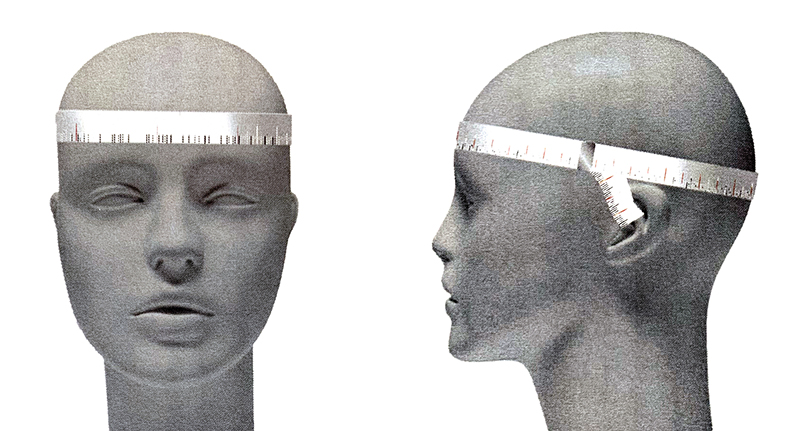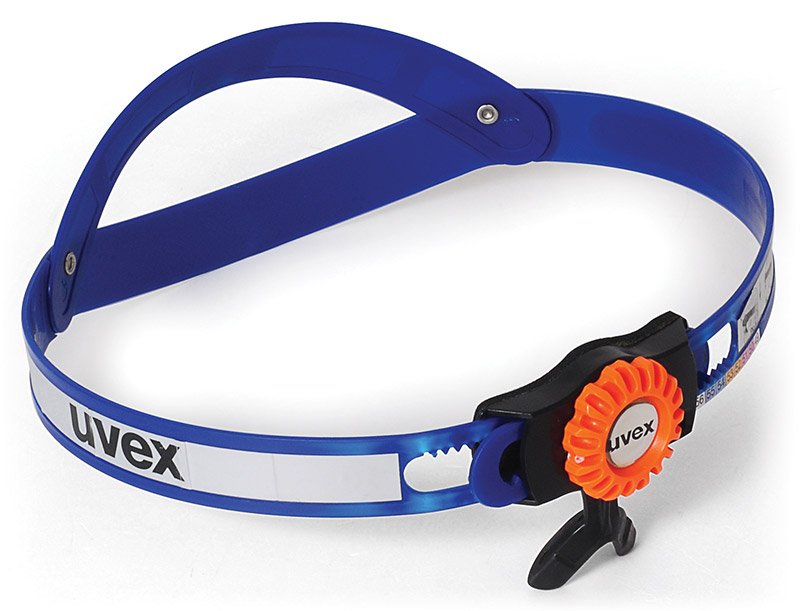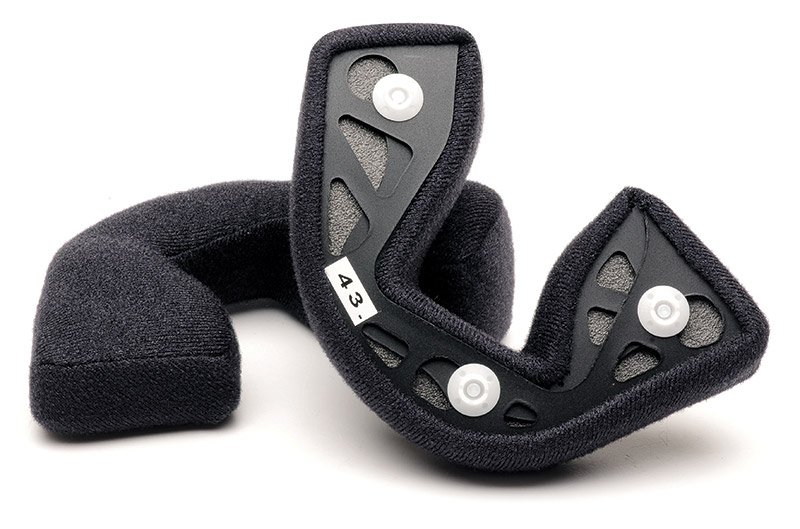Motorcycle helmet measurement and size guide
Published on: 07 August 2020
It’s pretty straightforward. Simply grab a measuring tape and measure the circumference of your head, starting a couple of centimetres above your eyebrows. Run the tape past the top of your ears to the back of your head (where the sticky out bit is) then carry on round back to the start. This will give you an approximate measurement of the circumference. It’s best to get this measurement in centimetres as this is what most helmets are listed in.

We often get asked ‘What size helmet do I need?’. Here in the shop, we have a device for measuring a head at exactly the position it should be measured; but even this is little more than a rough guide; a starting point, as it were.
And that’s because one head that measures 58cm can be very different to another. If you have a perfectly round skull you might well fit passably into most 58 motorcycle helmets, although of course some 58 helmets are 57/58, whilst others might be 58/59; enough to make a difference.

Here at Motolegends, we like customers to leave the shop with a motorcycle helmet that fits the way it is meant to. A helmet that doesn’t can be uncomfortable, and certainly one that is too tight can create a crippling headache.
A helmet that is too loose, by contrast, can end up being noisy. If it’s way too loose, it might even be dangerous.
But if you have a head that is significantly longer from front to back than it is from side to side, you might need to go to a 59 or 60 to avoid it being painful on the forehead. In doing so, though, you may well find that you need to put in thicker cheek pads to make up for the fact that it may be a little generous on the width front. A slightly thinner headlining might, of course, potentially prevent you from needing to go to a larger helmet.
Of course, different helmet brands fit slightly differently, and it may well be that if an Arai helmet doesn’t fit you well, a Shoei helmet or a Schuberth helmet might. But this notwithstanding, what is important to us is that a helmet has the facility for us to fit different thicknesses of head lining and cheek pad.
If somebody has a ‘pear-shaped’ face we may need to fit thicker cheekpads. But If somebody has a fuller face, we may need to do exactly the opposite, and fit thinner ones.

Shoei, Arai, Shark, Klim and Scorpion helmet size chart
| SIZE | HAT SIZE | CM |
| XS | 6 5/8 – 6 3/4 | 53-54 |
| S | 6 7/8 – 7 | 55-56 |
| M | 7 1/8 – 7 1/4 | 57-58 |
| L | 7 3/8 – 7 1/2 | 57-58 |
| XL | 7 5/8 – 7 3/4 | 61-62 |
| 2XL | 7 7/8 – 8 | 63-64 |
| 3XL | 8 1/8 – 8 1/4 | 65-66 |
Schuberth helmet size chart
| SIZE | CM |
| XS | 52-53 |
| S | 54-55 |
| M | 56-57 |
| L | 58-59 |
| XL | 60-61 |
| 2XL | 62-63 |
| 3XL | 64-65 |
We always thought we knew a thing or two about motorcycle gear, but since we’ve had the shop here in Guildford, and have had to meet our customers face-to-face, we’ve learned such a lot. Not so much about the technical side; more about the intricacies of fit, what is important to people, what makes them uncomfortable, and what works on the bike.
We’ve also come to realise that a lot of motorcyclists, even the experienced ones; in fact, sometimes even more so the experienced ones, don’t really know how gear is meant to be worn, and how it is meant to fit.
People pick up bad habits, get used to wearing stuff the wrong way, and have sometimes taken as gospel something some geezer told them 20 years ago in a bike shop. Even if that chap knew what he was on about back then, his advice almost certainly doesn’t apply today.
One of the things that brought this home to me was the conviction that some people have about their helmet size. Having run a tape measure around their head, they will sometimes tell us with great conviction that they are always a 57, for example, or a 62. They take the view that a helmet size is like a shoe size, and that one 56 helmet will fit the same as another. Unfortunately, it’s not like that in the helmet business. Every head is different, and sometimes you will take a different size even in helmets made by the same brand. But with a degree of certainty we can tell you that a 56 in a Shoei simply won’t fit the same as a 56 in a Schuberth.
Now sometimes you can put a helmet on, and it will fit perfectly; not too tight in the crown, a bit ‘chipmunky’ in the cheeks. And if a helmet works right out of the box, nobody is more delighted than we are.
But more often than not, we have found, we will want to make adjustments. The majority of bike clothing shops don’t want to do this. It simply takes too much time, and for no extra financial return. It is for this reason that, by and large, most retailers don’t hold differently-sized head linings and cheek pads in stock.
The better-known helmet manufacturers do usually offer this option. But even the most prestigious brands will normally only offer replacements for the standard cheek pads that fit into the different sized helmets. A Small helmet might have a 20mm cheekpads, whereas the Medium could have a 25mm, for example. But if you want to change the pads in a new helmet, the choice will be quite limited, and you would nearly always be expected to pay for the replacements.
Which may explain why we have become somewhat evangelical about Shoei’s helmets.
Shoei does things differently. Whereas some of the manufacturers achieve different sizing by putting thicker or thinner cheek pads in a given helmet shell, Shoei designs its helmets so that, with few exceptions, every size of helmet in the range takes a standard 35mm cheek pad and a 9mm head lining.
It means that, on every model, and in just about every size, you have the option of making the head-fit looser or tighter, and the same on the cheeks.
No other manufacturer out there offers anywhere near such micro adjustability. It’s why we reckon that we can make 99% of people comfortable in a Shoei.

In recent years, we have become huge Shoei fans. We think the quality of their manufacture is outstanding. But it is the ability to custom-fit a Shoei with different cheekpads and headliners that really puts clear blue water between Shoei and all the other makers.
Whilst we’re on the subject of helmet fit, there are just one or two urban myths that we wish to address.
The first is that there is such a thing as an ‘Arai’ shaped head, or a ‘Shoei’ head, or a ‘Schuberth’ head. We have lost count of the number of people who have come into the shop declaring that they have, for example, an Arai-shaped head, and that they always have been, and always will be, a Medium in an Arai.
These individuals show us perhaps the power our unconscious minds can exert over our actions.
If you tell yourself often enough that you have an Arai head, you perhaps come to believe it, and this self affirmation might just be enough to convince someone that a helmet fits well when the reality might just be that it doesn’t.
We can be pretty confident that this goes on because Arai, for example, has significantly changed its sizing many times over the last five to 10 years. What constituted an Arai fit 20 years ago has little resemblance to an Arai fit today. Yet the myth persists. The bottom line is this, however. Nobody has an Arai head, any more than they have a Shoei head, a Shark head or a Bell head.
There’s only one way to make sure that you get a helmet that fits properly, and that’s to visit a shop and try it on.
You want to go to the kind of specialist shop that has the commitment to make sure that its clothing fits properly, the kind of shop that has the knowledge and patience to get it right. But importantly, when it comes to helmets, they need to be the kind of dealer that carries on its shelves all the available internal liners.
The problem is that most dealers don’t. And that’s because, on some helmet models, say the Shoei Neotec 3 and the Schuberth C5 there are more than 20 changeable internal parts. We also know that the preeminent adventure helmet, the Arai Tour-X5, will be able to have amendments made to both the headliner and cheek pads. Stocking these pads allows us to make sure we can give you the best possible fit.
We’re an internet company; we sell a lot of helmets online and, of course, it is possible to get a helmet that fits well if you’re buying from a web-based company. Visiting a shop to get the right size before you buy online might help, but very few online sellers offer the option to buy different cheek pads and headliners. And none that we’ve come across offers the option to exchange them for another size for free.
The inconvenient truth when it comes to buying a crash helmet is this. A helmet is the single most important investment you’ll make when you ride a motorcycle It’s more important than the bike, the after-market exhaust, the satnav, the jackets, boots, gloves and so on.
For it to be comfortable, and more importantly safe, a helmet has to be properly fitted by somebody who knows what they’re on about. You won’t find these experts at every retailer. You won’t always even find them in a dealer whose name suggests that it specialises in helmets. And you’ll almost never find them in a dealership that also sells motorcycles!
Come and visit us, and we will always carry out a number of tests to check that a helmet fits properly. Not too tight. Not too loose. The word we like is ‘snug’. We’re still believers in the tried and trusted Police finger test, (no, not that finger test!). Push the helmet from behind in an attempt to create a gap above the eyebrows. If you cannot get a finger into that space the helmet is probably too tight. We’ll do a lateral movement test, and we’ll conduct a vertical friction test. In the latter case, if the helmet moves over the skin, the helmet is almost certainly too loose.

Personally, there aren’t that many retailers around the country we’d trust to do the job properly. We could probably count them on the fingers of one hand. We’d like to think that we’re one of that small group.
So if you’re trying a helmet on, and if it doesn’t fit quite as it should, and if it doesn’t feel quite right, ask whether they can change the fit. If they say that the helmet in question cannot be altered, ask to try on a different helmet; perhaps even a different brand. If they say that the helmet does have exchangeable parts, but that they don’t carry them, walk out and find a different retailer.
Quite simply, this is a decision that’s too important to take lightly. There’s nothing more distracting than a helmet that isn’t comfortable, nothing more painful than a helmet that is too tight, and nothing more dangerous than a helmet that doesn’t fit safely.
We know that it can be tempting to buy a helmet because its paint job matches your bike, but frankly that’s not the smartest way to buy what is, in effect, a highly important piece of safety equipment. Talk to somebody in the shop. Tell them what you ride, when you ride, and how you ride. And then let them make a recommendation. And once you’ve worked out the type and style of helmet you need, be guided by the three most important considerations: fit, fit and fit!
None of this is rocket science, but it really is worth taking a little time to get right.
Are you asking what motorcycle helmet should I choose? Read this: How to choose a motorcycle helmet.

































































